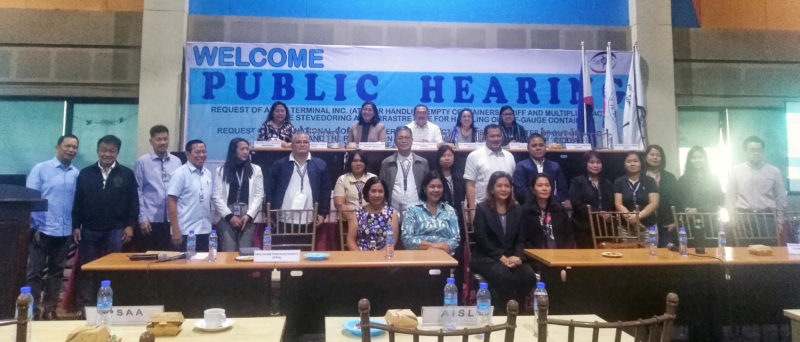
Port operators Asian Terminals Inc. (ATI) and International Container Terminal Services, Inc. (ICTSI) are asking the Philippine Ports Authority (PPA) to shorten the period for free storage of containers to better control dwell time.
Separately, ICTSI is seeking an adjustment of storage charges for out-of-gauge (OOG) shipments while ATI is proposing to establish a tariff for OOG shipments and arrastre rates for handling empty containers.
ATI wants to cut the allowed free storage period to seven days from 10—with storage starting from date of the Bureau of Customs’ (BOC) Online Release System (OLRS)—before penalties are imposed. The proposal aims to reduce the average dwell time of containers at Manila South Harbor, said ATI assistant vice president for business development Edward Ian Baking at a public hearing on January 24.
Baking said reducing the period before penalties are imposed “will naturally control the dwell time of containers.”
Data from ATI showed that the percentage of cargo owners able to release cargoes within 10 days peaked at 98% in 2016, then fell to 94% in 2019. Cargo owners who withdrew their cargoes within seven days were at 95% in 2016 and at 89% in 2019.
Baking noted that by reducing container dwell time by one day, yard capacity can increase by 200,000 twenty-foot equivalent units (TEU) without having to expand the yard.
ICTSI, on the other hand, is petitioning for the immediate start of the free storage period on the actual day the container is discharged from the carrying vessel, instead of the current rule where the free storage period starts after date of discharge of the last package from the carrying vessel.
ICTSI is also requesting that the reckoning time of the storage day start from the actual time the container is discharged from the carrying vessel, instead of the current policy of reckoning time of storage day starting from 7:01 a.m. up to 7:00 a.m. of the next day.
Manila International Container Terminal (MICT) management services and government affairs director Voltaire Wycoco, at the same public hearing, said ICTSI’s proposal seeks to reduce the effect of container dwell time on capacity and prevent high yard utilization at MICT, which will result in increased productivity, more efficient use of resources, and faster landside delivery.
“As much as we’d like to maintain five days [of] container dwell time to achieve our goals, policies make it that it’s not possible,” Wycoco noted.
He explained that the current policy of reckoning the period of free storage gives some containers an additional one or even two days of free storage. Wycoco said that more than 90% of ships calling MICT carry around 1,000 containers, and discharging all may take one or two days; thus, some containers “get to stay as much as seven days for free inside MICT.”
Wycoco said implementing ICTSI’s proposal is easily implementable because MICT’s terminal operating system’s record of actual container arrival time and information on container status are readily available.
He said the proposal will likewise help distribute deliveries over a 24-hour period, alleviating today’s scenario of trucks bunching at 6:00 a.m. to 7:00 a.m., which is the time of storage expiry.
At the same time, ICTSI is proposing to adjust storage charges for OOG shipments to bring their dwell times to more manageable levels. An OOG shipment is any cargo that cannot be loaded into six-sided shipping containers for being too large.
Wycoco noted that OOGs’ dwell times have increased from 10 days in 2017 to 14 days in 2019.
ATI’s Baking also noted that dwell times of OOG shipments are longer than containerized cargoes, averaging at 10 days as compared to seven days for containers. The volume of OOG shipments handled at Manila South Harbor has also increased by an average of 27% since 2006, presenting “certain complexities” to the terminal’s operations.
Handling of OOG shipments affects operations on both the ship side and yard side, as unloading an OOG shipment takes longer than a container. OOG cargoes also occupy more yard space as they cannot be stacked like containers.
ATI is thus petitioning for a specific tariff for handling OOG shipments, to be computed as six times the applicable stevedoring, arrastre, and storage tariff rates of containers.
In addition, the Manila South Harbor operator is proposing the application of an arrastre tariff for handling empty containers, volumes of which have increased over the past years. Baking said there is tariff on empty containers, but this is limited to stevedoring, even when the port provides other services such as handling and trucking. – Roumina Pablo





